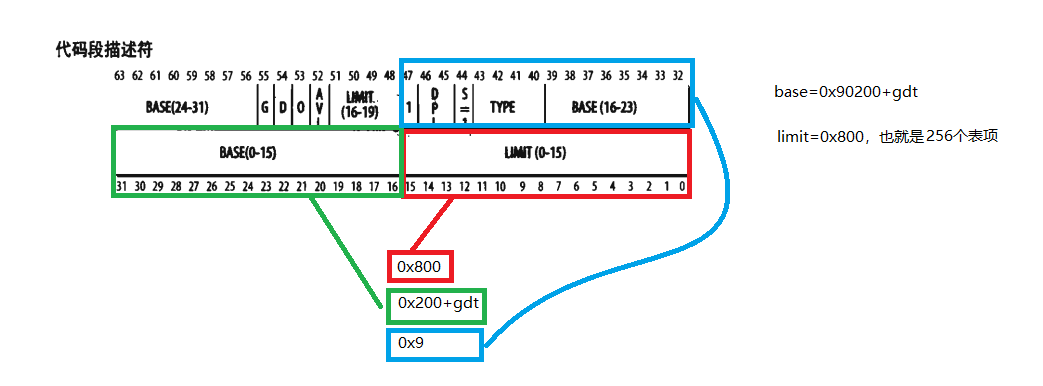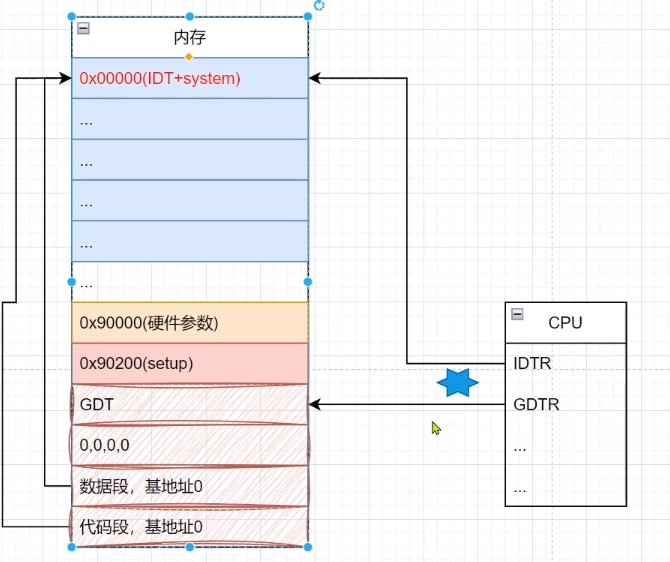kernel源码(六)setup.s
1 源码

! ! setup.s (C) 1991 Linus Torvalds ! ! setup.s is responsible for getting the system data from the BIOS, ! and putting them into the appropriate places in system memory. ! both setup.s and system has been loaded by the bootblock. ! ! This code asks the bios for memory/disk/other parameters, and ! puts them in a "safe" place: 0x90000-0x901FF, ie where the ! boot-block used to be. It is then up to the protected mode ! system to read them from there before the area is overwritten ! for buffer-blocks. ! ! NOTE! These had better be the same as in bootsect.s! INITSEG = 0x9000 ! we move boot here - out of the way SYSSEG = 0x1000 ! system loaded at 0x10000 (65536). SETUPSEG = 0x9020 ! this is the current segment .globl begtext, begdata, begbss, endtext, enddata, endbss .text begtext: .data begdata: .bss begbss: .text entry start start: ! ok, the read went well so we get current cursor position and save it for ! posterity. mov ax,#INITSEG ! this is done in bootsect already, but... mov ds,ax mov ah,#0x03 ! read cursor pos xor bh,bh int 0x10 ! save it in known place, con_init fetches mov [0],dx ! it from 0x90000. ! Get memory size (extended mem, kB) mov ah,#0x88 int 0x15 mov [2],ax ! Get video-card data: mov ah,#0x0f int 0x10 mov [4],bx ! bh = display page mov [6],ax ! al = video mode, ah = window width ! check for EGA/VGA and some config parameters mov ah,#0x12 mov bl,#0x10 int 0x10 mov [8],ax mov [10],bx mov [12],cx ! Get hd0 data mov ax,#0x0000 mov ds,ax lds si,[4*0x41] mov ax,#INITSEG mov es,ax mov di,#0x0080 mov cx,#0x10 rep movsb ! Get hd1 data mov ax,#0x0000 mov ds,ax lds si,[4*0x46] mov ax,#INITSEG mov es,ax mov di,#0x0090 mov cx,#0x10 rep movsb ! Check that there IS a hd1 :-) mov ax,#0x01500 mov dl,#0x81 int 0x13 jc no_disk1 cmp ah,#3 je is_disk1 no_disk1: mov ax,#INITSEG mov es,ax mov di,#0x0090 mov cx,#0x10 mov ax,#0x00 rep stosb is_disk1: ! now we want to move to protected mode ... cli ! no interrupts allowed ! ! first we move the system to it's rightful place mov ax,#0x0000 cld ! 'direction'=0, movs moves forward do_move: mov es,ax ! destination segment add ax,#0x1000 cmp ax,#0x9000 jz end_move mov ds,ax ! source segment sub di,di sub si,si mov cx,#0x8000 rep movsw jmp do_move ! then we load the segment descriptors end_move: mov ax,#SETUPSEG ! right, forgot this at first. didn't work :-) mov ds,ax lidt idt_48 ! load idt with 0,0 lgdt gdt_48 ! load gdt with whatever appropriate ! that was painless, now we enable A20 call empty_8042 mov al,#0xD1 ! command write out #0x64,al call empty_8042 mov al,#0xDF ! A20 on out #0x60,al call empty_8042 ! well, that went ok, I hope. Now we have to reprogram the interrupts :-( ! we put them right after the intel-reserved hardware interrupts, at ! int 0x20-0x2F. There they won't mess up anything. Sadly IBM really ! messed this up with the original PC, and they haven't been able to ! rectify it afterwards. Thus the bios puts interrupts at 0x08-0x0f, ! which is used for the internal hardware interrupts as well. We just ! have to reprogram the 8259's, and it isn't fun. mov al,#0x11 ! initialization sequence out #0x20,al ! send it to 8259A-1 .word 0x00eb,0x00eb ! jmp $+2, jmp $+2 out #0xA0,al ! and to 8259A-2 .word 0x00eb,0x00eb mov al,#0x20 ! start of hardware int's (0x20) out #0x21,al .word 0x00eb,0x00eb mov al,#0x28 ! start of hardware int's 2 (0x28) out #0xA1,al .word 0x00eb,0x00eb mov al,#0x04 ! 8259-1 is master out #0x21,al .word 0x00eb,0x00eb mov al,#0x02 ! 8259-2 is slave out #0xA1,al .word 0x00eb,0x00eb mov al,#0x01 ! 8086 mode for both out #0x21,al .word 0x00eb,0x00eb out #0xA1,al .word 0x00eb,0x00eb mov al,#0xFF ! mask off all interrupts for now out #0x21,al .word 0x00eb,0x00eb out #0xA1,al ! well, that certainly wasn't fun :-(. Hopefully it works, and we don't ! need no steenking BIOS anyway (except for the initial loading :-). ! The BIOS-routine wants lots of unnecessary data, and it's less ! "interesting" anyway. This is how REAL programmers do it. ! ! Well, now's the time to actually move into protected mode. To make ! things as simple as possible, we do no register set-up or anything, ! we let the gnu-compiled 32-bit programs do that. We just jump to ! absolute address 0x00000, in 32-bit protected mode. mov ax,#0x0001 ! protected mode (PE) bit lmsw ax ! This is it! jmpi 0,8 ! jmp offset 0 of segment 8 (cs) ! This routine checks that the keyboard command queue is empty ! No timeout is used - if this hangs there is something wrong with ! the machine, and we probably couldn't proceed anyway. empty_8042: .word 0x00eb,0x00eb in al,#0x64 ! 8042 status port test al,#2 ! is input buffer full? jnz empty_8042 ! yes - loop ret gdt: .word 0,0,0,0 ! dummy .word 0x07FF ! 8Mb - limit=2047 (2048*4096=8Mb) .word 0x0000 ! base address=0 .word 0x9A00 ! code read/exec .word 0x00C0 ! granularity=4096, 386 .word 0x07FF ! 8Mb - limit=2047 (2048*4096=8Mb) .word 0x0000 ! base address=0 .word 0x9200 ! data read/write .word 0x00C0 ! granularity=4096, 386 idt_48: .word 0 ! idt limit=0 .word 0,0 ! idt base=0L gdt_48: .word 0x800 ! gdt limit=2048, 256 GDT entries .word 512+gdt,0x9 ! gdt base = 0X9xxxx .text endtext: .data enddata: .bss endbss:
2 分析
设置数据段寄存器ds到0x90000位置。在bootsect.s中我们移动bootsect.s到0x90000位置,移动setup.s到0x90200位置,这里我们覆盖bootsect.s。
读取光标位置并存储在相对0x90000的[0]位置
! ok, the read went well so we get current cursor position and save it for ! posterity. mov ax,#INITSEG ! this is done in bootsect already, but... mov ds,ax //设置数据段寄存器为0x90000, mov ah,#0x03 ! read cursor pos xor bh,bh int 0x10 ! 调用BIOS中断,功能号为0x03,入参bh=0表示显示页码,出口参数为:dh为行,dl为列
mov [0],dx ! 保存中断返回的光标位置到0x90000处,dx为16位,ds为8位,实际占用ds[0]和ds[1]
注:BIOS中断向量表:https://blog.csdn.net/weixin_37656939/article/details/79684611
获取扩展内存大小
! Get memory size (extended mem, kB) mov ah,#0x88 int 0x15 //调用BIOS中断,功能号0x15,入参:ah=0x88表示获取扩展内存大小,出口参数:ax:扩展内存大小(单位KB) mov [2],ax //把读取的扩展内存大小存入0x90002位置
获取显示卡数据
! Get video-card data: mov ah,#0x0f int 0x10 //调用BIOS中断,功能号0x10,入参:ah=0x0f表示获取显示器模式,出口参数:bh页码,ah屏幕字符的列数,al显示模式 mov [4],bx ! 把获取的页码存入0x90004位置 mov [6],ax ! 把获取的屏幕宽度和显示模式放入0x90006位置
获取显示参数:
! check for EGA/VGA and some config parameters mov ah,#0x12 mov bl,#0x10 int 0x10 //调用BIOS中断,功能号0x10,入参:bl=0x10 mov [8],ax mov [10],bx //安装的显示内存放入相对0x90000位置10处 mov [12],cx //显示卡的特性放到相对0x90000位置12处
取第一个硬盘的信息
此处没有使用bios中断获取硬盘信息,因为bios中断向量表已经被加载到0-0x3FF位置,其中该范围内的0x41处存放的是一个地址指针,指向第0块硬盘的参数表(此处的bios中断向量0x41和0x13不同,0x13存放的是一个中断调用,而0x41存放的是硬盘参数表的指针)
第一个硬盘的参数表首地址是中断向量0x41的向量值。硬盘参数表的长度是16字节
lds指令的功能是把mem指向的地址,高位存放在DS中,低位存放在reg中
rep是循环指令,循环执行其下的一条指令,直到cx=0为止。
! Get hd0 data mov ax,#0x0000 mov ds,ax //段的基地址改为0x0000 lds si,[4*0x41] //取相对0x0000处0x41处开始取16字节,高8字节放入ds中,低8字节放入源变址寄存器si中 mov ax,#INITSEG mov es,ax //附加段es基地址设置为0x9000 mov di,#0x0080 es段的目的变址寄存器设置为0x0080 mov cx,#0x10 rep movsb
上面代码最后两行,循环执行movsb,movsb是串传送指令,将ds:si处的值传送到es:di中,每次传送1字节。每循环一次cx减1,直到减到0为止。这里的功能是把硬盘参数表放到es段的0x0080开始的位置,共16字节。
下面代码是获取第二个磁盘的参数表放到es段的0x0090开始的位置,共16字节。
! Get hd1 data mov ax,#0x0000 mov ds,ax lds si,[4*0x46] mov ax,#INITSEG mov es,ax mov di,#0x0090 mov cx,#0x10 rep movsb
判断是否存在hd1(因为Linus开发内核时,把文件系统放到第二个硬盘中,所以有这个硬盘,但是其他人可能只有一个硬盘,这里判断是否存在hd1,如果不存在,把hd1信息清空)
! Check that there IS a hd1 :-) mov ax,#0x01500 mov dl,#0x81 int 0x13 jc no_disk1 cmp ah,#3 je is_disk1
如果没有hd1,则将0x90090开始的16个字节处理掉。
no_disk1: mov ax,#INITSEG mov es,ax mov di,#0x0090 mov cx,#0x10 mov ax,#0x00 rep stosb
如果有disk1,则开始启用保护模式
is_disk1: ! now we want to move to protected mode ... cli ! Clear Interupt,该指令用于禁用中断,为什么要首先关闭中断呢?因为接下来要把system模块从0x1000移动到0x0位置处,而此位置存放的是bios中断向量表,如果不关闭中断,调用中断向量表时会找不到对应中断向量,会出问题,所以,先关闭中断 ! first we move the system to it's rightful place mov ax,#0x0000 !ax寄存器赋值0x000 cld ! 标志寄存器FLAGS中的fd标志清零
把0x10000到0x90000的内存段移动到0x0000开始的位置。通过https://www.cnblogs.com/zhenjingcool/p/15938085.html显示的示意图我们知道,0x10000到0x90000存放的是system模块,这里我们把system模块移动到0x0000开始的位置。
do_move: mov es,ax ! destination segment add ax,#0x1000 //ax初始值为0x000,这里首先ax=ax+0x1000,也就是加64KB cmp ax,#0x9000 //判断是否到达0x9000位置 jz end_move //如果到达0x9000位置,说明我们已经移动完毕 mov ds,ax ! 否则ds赋值为0x1000 sub di,di //源变址寄存器清零 sub si,si //目的变址寄存器清零 mov cx,#0x8000 计数寄存器cx置为0x8000 (2^115=2^6K=32K),表示循环32K次,每次传送1个字,共传送32K字,也就是64K字节,即64KB rep //循环 movsw //传送1个字,从ds:si到es:di jmp do_move
如果移动完,则跳转到end_move
加载段描述符(全局描述符表和中断描述符表)
! then we load the segment descriptors end_move: mov ax,#SETUPSEG ! right, forgot this at first. didn't work :-) mov ds,ax //数据段的基地址移动到0x9020处 lidt idt_48 ! lidt指令用于加载idt。加载中断描述符表idt到idtr寄存器中,其中idt_48在下面定义。idt_48共48位,都是0,也就是说,中断描述符寄存器idtr指向内存0处 lgdt gdt_48 ! lgdt指令用于加载gdt。加载全局描述符表gdt到gdtr寄存器中
gdt: .word 0,0,0,0 ! dummy .word 0x07FF ! 8Mb - limit=2047 (2048*4096=8Mb) .word 0x0000 ! base address=0 .word 0x9A00 ! code read/exec .word 0x00C0 ! granularity=4096, 386 .word 0x07FF ! 8Mb - limit=2047 (2048*4096=8Mb) .word 0x0000 ! base address=0 .word 0x9200 ! data read/write .word 0x00C0 ! granularity=4096, 386 idt_48: //这里定义了3个word,每个word16位,共48位。这里相当于定义的中断描述符表共48位,每位全为0。 .word 0 ! idt limit=0 .word 0,0 ! idt base=0L gdt_48: //这里定义了3个word,共48位。 .word 0x800 ! gdt limit=2048, 256 GDT entries .word 512+gdt,0x9 ! gdt base = 0X9xxxx,512是十进制,对应的十六进制为0x200。gdt在上面定义,定义了12个word,也就是初始的全局描述符表。
上述对gdt_48的描述可比照下图查看会比较明了

也即是说,从0x90200开始连续存放了3个gdt表项。这些表项的限长都是0x800.
达到的效果如下图所示

开启A20地址线。只有开启A20地址线,我们才能够访问1M以上的内存。(代码暂时不解释,只要知道这里功能是开启A20地址线)
! that was painless, now we enable A20 call empty_8042 mov al,#0xD1 ! command write out #0x64,al call empty_8042 mov al,#0xDF ! A20 on out #0x60,al call empty_8042
重新设置8259A控制器(8259A是专门为8086/8088进行中断控制而设计的芯片),这段代码暂时不讲,下一篇再详细讲述
! well, that went ok, I hope. Now we have to reprogram the interrupts :-( ! we put them right after the intel-reserved hardware interrupts, at ! int 0x20-0x2F. There they won't mess up anything. Sadly IBM really ! messed this up with the original PC, and they haven't been able to ! rectify it afterwards. Thus the bios puts interrupts at 0x08-0x0f, ! which is used for the internal hardware interrupts as well. We just ! have to reprogram the 8259's, and it isn't fun. mov al,#0x11 ! initialization sequence out #0x20,al ! send it to 8259A-1 .word 0x00eb,0x00eb ! jmp $+2, jmp $+2 out #0xA0,al ! and to 8259A-2 .word 0x00eb,0x00eb mov al,#0x20 ! start of hardware int's (0x20) out #0x21,al .word 0x00eb,0x00eb mov al,#0x28 ! start of hardware int's 2 (0x28) out #0xA1,al .word 0x00eb,0x00eb mov al,#0x04 ! 8259-1 is master out #0x21,al .word 0x00eb,0x00eb mov al,#0x02 ! 8259-2 is slave out #0xA1,al .word 0x00eb,0x00eb mov al,#0x01 ! 8086 mode for both out #0x21,al .word 0x00eb,0x00eb out #0xA1,al .word 0x00eb,0x00eb mov al,#0xFF ! mask off all interrupts for now out #0x21,al .word 0x00eb,0x00eb out #0xA1,al
lmsw(load machine status word)加载机器状态字。也就是控制寄存器CR0的PE(protected enable)位设置为1,开启保护模式。后续再修改段寄存器,将修改的是段的选择符,而不是段的基地址(参考https://www.cnblogs.com/zhenjingcool/p/15929907.html)。
跳转到0x0000位置。
mov ax,#0x0001 ! protected mode (PE) bit lmsw ax ! This is it! jmpi 0,8 ! jmp offset 0 of segment 8 (cs),跳转到段选择子为8(二进制为1000),偏移地址为0的位置处
其中 jmpi 0,8 是我们要特别注意的地方,它是关键点。
jmpi指令是段间跳转指令。这条指令作用是跳转到段选择子为8(二进制是1000)的位置0处。通过https://www.cnblogs.com/zhenjingcool/p/15929907.html我们了解到,段选择子格式

低两位为00,TI位为0表示访问全局描述符表GDT,index为1表示GDT中的第1位(首位为第0位)
初始化的GDT为
gdt: .word 0,0,0,0 ! dummy .word 0x07FF ! 8Mb - limit=2047 (2048*4096=8Mb) .word 0x0000 ! base address=0 .word 0x9A00 ! code read/exec .word 0x00C0 ! granularity=4096, 386 .word 0x07FF ! 8Mb - limit=2047 (2048*4096=8Mb) .word 0x0000 ! base address=0 .word 0x9200 ! data read/write .word 0x00C0 ! granularity=4096, 386
第0位保留不用,第1位为
.word 0x07FF ! 8Mb - limit=2047 (2048*4096=8Mb) .word 0x0000 ! base address=0 .word 0x9A00 ! code read/exec .word 0x00C0 ! granularity=4096, 386
intel规定下(低位)上(高位),对照

我们可知,BASE为0x00000000(32位)
也就是说执行 jmpi 0,8 将跳转到0x0000处。前面我们介绍过,0x0000位置为system模块存放的地址,也就是说接下来将执行system模块中的head.s。






【推荐】国内首个AI IDE,深度理解中文开发场景,立即下载体验Trae
【推荐】编程新体验,更懂你的AI,立即体验豆包MarsCode编程助手
【推荐】抖音旗下AI助手豆包,你的智能百科全书,全免费不限次数
【推荐】轻量又高性能的 SSH 工具 IShell:AI 加持,快人一步
· 无需6万激活码!GitHub神秘组织3小时极速复刻Manus,手把手教你使用OpenManus搭建本
· C#/.NET/.NET Core优秀项目和框架2025年2月简报
· Manus爆火,是硬核还是营销?
· 终于写完轮子一部分:tcp代理 了,记录一下
· 【杭电多校比赛记录】2025“钉耙编程”中国大学生算法设计春季联赛(1)